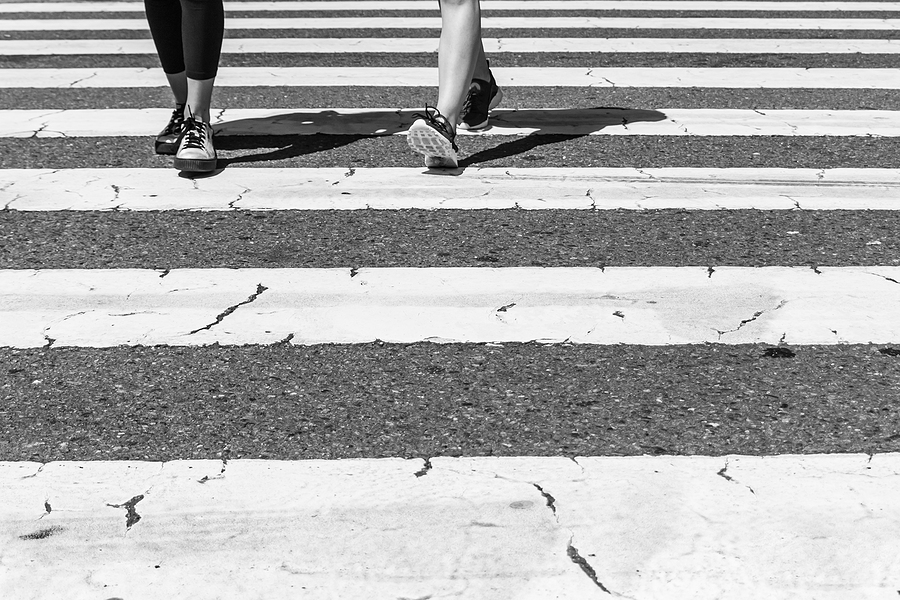Florida is notorious for being one of the worst states in the country to take a walk. Pedestrian accidents occur in our state far too often, resulting in devastating injuries and fatalities. If you’ve been involved in an accident, you may be asking, “can a pedestrian be at fault?” While motorists cause these accidents in most cases, there are instances where a pedestrian’s negligence can have catastrophic outcomes.

Collisions between cars and pedestrians can lead to complex personal injury cases. You need a pedestrian accident attorney to protect your rights and help you obtain as much compensation as possible. The Eberst Firm is ready to do just that. We’ll be here to answer all of your questions and tell you what to expect at every turn. Please schedule a free evaluation of your case by contacting us online or calling 1-888-CALL-JON as soon as possible.
Common Causes of Pedestrian Accidents
Again, the most common cause of a pedestrian accident is motorist negligence. The following are just a few examples.
- Distracted driving – Motorists prioritize looking at their smartphones over focusing on their surroundings. Distracted driving significantly increases the risk of an accident.
- Impaired driving – When someone drunk or high is behind the wheel, they can’t react as quickly to sudden changes. These changes often include pedestrians suddenly appearing out of nowhere. An impaired driver won’t be able to stop as a sober motorist would.
- Road rage – Everyone has tried to drive while having a terrible day. But some motorists get so enraged they have no regard for anyone else’s safety. This can also substantially increase the chances of hitting a pedestrian or another vehicle.
Situations in Which a Pedestrian May be at Fault
But there are other instances where a pedestrian causes an accident. Pedestrians are just as responsible for obeying the law as drivers, and severe injuries or deaths can result when they fail to do so. Here are two of the ways pedestrians can cause accidents.
- Failing to use the crosswalk – As long as the traffic light is red and the “walk” light is showing, pedestrians have the right of way at a crosswalk. But if an intersection doesn’t have a crosswalk, drivers still have to come to a complete stop. Also, drivers have the right of way if the traffic light is green. If a pedestrian fails to use an available crosswalk and causes an accident (a practice known as jaywalking), the pedestrian will be responsible.
- Failing to use the sidewalk – A pedestrian must use a sidewalk whenever one is available. When someone chooses to walk on the street instead, they can be liable for any accident they cause. When pedestrians must walk on the road because there’s no sidewalk, they must walk in the direction facing traffic.
How to Determine Fault in a Florida Pedestrian Accident Case
You’ll need an experienced lawyer if you’ve suffered an injury in a pedestrian accident that wasn’t your fault. One main reason is that your attorney will need to investigate to determine who was to blame. This investigation needs to start as quickly as possible before critical evidence disappears.
Who Will Pay Your Medical Bills if You Cause an Accident as a Pedestrian?
Florida is one of the few “no-fault” states in the country. As a result, your PIP (personal injury protection) or no-fault insurance will pay some of your medical bills. Insurance will also pay a portion of some other accident-related expenses, such as transportation and household services.
Florida is also a “comparative negligence” state. Even if you caused the collision, there’s a good chance the driver also shoulders some blame. They might, for instance, have been speeding or impaired, and the driver might have failed to maintain the vehicle properly, and the brakes didn’t work correctly.
If an investigation shows the driver was partly at fault, that will affect your compensation. Suppose your damages total $100,000, and you’re assigned 40% of the blame. You’ll lose 40% of your compensation, meaning you’ll receive $60,000 instead of $100,000. But if the investigation shows you were 51% or more to blame, you won’t receive anything.
Types of Evidence Used to Build a Case Against a Pedestrian or Motor Vehicle Driver
Your attorney’s investigation will produce evidence to help you obtain as much compensation as possible. Lawyers look for several different types of evidence, such as video from surveillance cameras near the accident scene. Your attorney will also use the police report, interview witnesses, and look for other proof you weren’t totally to blame.
How to Prevent an Accident as a Pedestrian
As a pedestrian, it’s essential to take precautions to avoid accidents while walking. Here are a few to keep in mind:
- Stay visible: Make sure that you wear bright or reflective clothing, especially at night, to ensure that drivers can see you.
- Cross at crosswalks: Always use marked crosswalks when crossing the street. Follow the pedestrian signals and wait for the “walk” signal before entering the street.
- Look both ways: Before crossing any street, look for oncoming traffic. Make sure it’s safe to cross and pay attention to any turning vehicles.
- Avoid distractions: Avoid distractions such as using your phone, listening to music, or taking your attention off the road.
- Stay alert: Always be alert and aware of your surroundings, especially near busy intersections.
- Follow the rules of the road: Follow traffic laws, pedestrian signals, and road signs. Avoid jaywalking, which can be dangerous.
- Walk facing traffic: If there are no sidewalks, walk facing oncoming traffic so you can see any cars coming towards you.
Following these simple safety measures can significantly reduce your risk of getting into an accident as a pedestrian. Remember, safety should always be your top priority when walking on the streets.
Contact The Eberst Law Firm Today to Speak with an Experienced Pedestrian Accident Attorney to Discuss Your Options
Get in touch with The Eberst Law Firm for a free consultation, whether you were a driver or pedestrian at the time of the accident. You can contact us online or call 1-888-CALL-JON.
